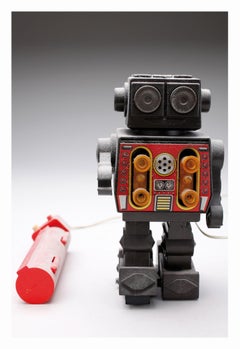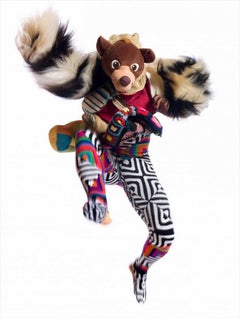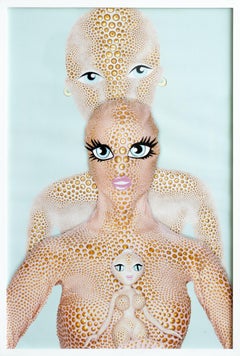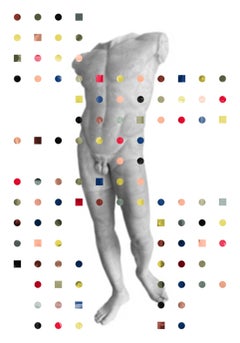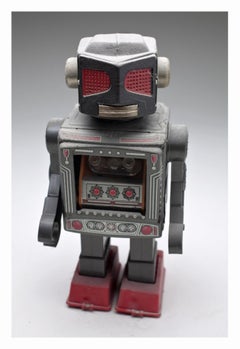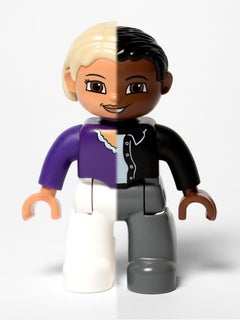Toy Figurative Photography
to
2
12
5
5
13
15
Overall Width
to
Overall Height
to
2
48
1
1
21
4
3
2
1
41
6
3
602
13,944
7,193
5,855
3,867
3,111
2,519
1,911
1,894
1,692
1,509
1,393
1,318
1,284
1,009
972
968
916
883
844
18
18
13
8
7
11
8
5
3
2
14
9
27
23
Art Subject: Toy
Untitled (from ROBOTNICS Series)
Located in Kansas City, MO
Christian Rothmann
ROBOTNICS Series
C-Print
2019
Edition S (Edition of 10)
12 x 8.3 inches (30.5 x 21 cm)
Signed, dated and numbered verso
Other Edition Sizes available:
- Edition M (Edition of 6) 35.4 x 23.6 inches (90 x 60 cm)
- Edition L (Edition of 6) 47.2 x 31.5 inches (120 x 80 cm)
- Edition XL (Edition of 3) 88.8 x 58.8 inches (225 x 150 cm)
PUR - Price Upon Request
--------------
Since 1979 Christian Rothmann had more than 40 solo and 80 group exhibitions worldwide.
Christian Rothmann had guest lectures, residencies, art fairs and biennials in Europe, Japan, USA, Australia and Korea.
Christian Rothmann (born 1954 in Kędzierzyn, Poland ) is a painter, photographer, and graphic artist.
In 1976 he first studied at the “Hochschule für Gestaltung” in Offenbach, Germany and moved to Berlin in 1977, where he graduated in 1983 at the “Hochschule der Künste”. From 1983 to 1995 he taught at the university as a lecturer and as an artist with a focus on screenprinting and American art history. To date, a versatile body of work has been created, which includes not only paintings but also long-standing photo projects, videos, and public art.
Guest lectures, teaching assignments, scholarships and exhibitions regularly lead Rothmann to travel home and abroad.
------------------------
Rothmann's Robots
These creatures date back to another era, and they connect the past and the future. They were found by Christian Rothmann, a Berlin artist, collector and traveler through time and the world: In shops in Germany and Japan, Israel and America, his keen eye picks out objects cast aside by previous generations, but which lend themselves to his own work. In a similar way, he came across a stash of historic toy robots of varied provenance collected by a Berlin gallery owner many years ago. Most of them were screwed and riveted together in the 1960s and 70s by Metal House, a Japanese company that still exists today. In systematically photographing these humanoids made of tin - and later plastic - Rothmann is paraphrasing the idea of appropriation art. Unknown names designed and made the toys, which some five decades on, Rothmann depicts and emblematizes in his extensive photo sequence.
In their photographs of Selim Varol's vast toy collection, his German colleagues Daniel and Geo Fuchs captured both the stereotypical and individual in plastic figures that imitate superheroes which were and still are generally manufactured somewhere in Asia. Christian Rothmann looks his robots deep in their artificially stylized, painted or corrugated eyes - or more aptly, their eye slits - and although each has a certain degree of individuality, the little figures remain unknown to us; they project nothing and are not alter egos. Rothmann trains his lens on their faces and expressions, and thus, his portraits are born. Up extremely close, dust, dents, and rust become visible. In other words, what we see is time-traces of time that has passed since the figures were made, or during their period in a Berlin attic, and - considering that he robots date back to Rothmann's childhood - time lived by the photographer and recipients of his pictures. But unlike dolls, these mechanical robots bear no reference to the ideal of beauty at the time of their manufacture, and their features are in no way modeled on a concrete child's face.
In this art project the robots appear as figures without a context, photographed face-on, cropped in front of a neutral background and reduced to their qualities of form. But beyond the reproduction and documentation a game with surfaces is going on; our view lingers on the outer skin of the object, or on the layer over it. The inside - which can be found beneath - is to an extent metaphysical, occurring inside the observer's mind. Only rarely is there anything to see behind the robot's helmet. When an occasional human face does peer out, it turns the figure into a robot-like protective casing for an astronaut of the future.
If we really stop and think about modern toys, let's say those produced from the mid 20th century, when Disney and Marvel films were already stimulating a massive appetite for merchandising, the question must be: do such fantasy and hybrid creatures belong, does something like artificial intelligence already belong to the broader community of humans and animals? It is already a decade or two since the wave of Tamagotchis washed in from Japan, moved children to feed and entertain their newly born electronic chicks in the way they would a real pet, or to run the risk of seeing them die. It was a new form of artificial life, but the relationship between people and machines becomes problematic when the machines or humanoid robots have excellent fine motor skills and artificial intelligence and sensitivity on a par with, or even greater than that of humans. Luckily we have not reached that point yet, even if Hollywood adaptations would have us believe we are not far away.
Rothmann's robots are initially sweet toys, and each toy is known to have a different effect on children and adults. They are conceived by (adult) designers as a means of translating or retelling history or reality through miniature animals, knights, and soldiers. In the case of monsters, mythical creatures, and robots, it is more about creating visions of the future and parallel worlds. Certainly, since the success of fantasy books and films such as Lord of the Rings or The Hobbit, we see the potential for vast enthusiasm for such parallel worlds. Successful computer and online games such as World
of Warcraft, or the creation of avatars are also interesting worldwide phenomena of virtual realities that are not only relevant for children and teens.
So when a middle-aged Berlin photographic artist (like Christian Rothmann) chooses to study 120 toy robots with great difference in form, it represents a journey back to his own childhood - even if at the time, he played with a steam engine rather than a robot. Once batteries had been inserted, some of the largely male or gender-neutral robots, could flash, shoot, turn around and even do more complicated things. Some can even still do it today - albeit clumsily. This, of course, can only be seen on film, but the artist intends to document that as well; to feature the robots in filmic works of art.
The positioning of the figures in the studio is the same as the tableau of pictures in the exhibition room. In this way, one could say Rothmann deploys one robot after the other. This systematic approach enables a comparative view; the extreme enlargement of what are actually small and manageable figures is like the macro vision of insects whose fascinating, sometimes monster-like appearance only becomes visible when they are blown up a hundredfold. The same thing goes for the robots; in miniature form, they seem harmless and cute, but if they were larger than humans and made noises to match, they would seem more threatening.
Some of the tin figures...
Category
2010s Street Art Photography
Materials
C Print
Soundsuit #6 (Performance Art, Artistic Expression, Contemporary Art)
By Nick Cave
Located in Kansas City, MO
Nick Cave
Soundsuit #6
Year: 2010
Archival Pigment Print on Premium Rag
Size: 17 x 12 in.
Edition: 200
Signed by hand on label
COA provided
Ref.: 924802-2069
Tags: #NickCave #Missou...
Category
2010s Contemporary Figurative Photography
Materials
Archival Paper, Archival Pigment
"This Is Not A Composite" Barbie-inspired, pigment print on archival paper
By PJ Linden
Located in Philadelphia, PA
This piece titled "This Is Not A Composite" is an original artwork by PJ Linden and is made from digital photography, pigment print on archival paper, and framed with glass. This pie...
Category
21st Century and Contemporary Contemporary Figurative Photography
Materials
Archival Pigment
Untitled VI. From The Balance Series
Located in Miami Beach, FL
Untitled VI, 2022 by Salvatore Arnone
From the Balance series
Photographic print on paper
Image size: 50 in. H x 35 in. W
Edition of 3 + 1AP
Production time is 2 to 3 weeks.
Unframed...
Category
2010s Contemporary Nude Photography
Materials
Archival Pigment
Untitled (from ROBOTNICS Series)
Located in Kansas City, MO
Christian Rothmann
ROBOTNICS Series
C-Print
2019
Edition S (Edition of 10)
12 x 8.3 inches (30.5 x 21 cm)
Signed, dated and numbered verso
Other Edition Sizes available:
- Edition M (Edition of 6) 35.4 x 23.6 inches (90 x 60 cm)
- Edition L (Edition of 6) 47.2 x 31.5 inches (120 x 80 cm)
- Edition XL (Edition of 3) 88.8 x 58.8 inches (225 x 150 cm)
PUR - Price Upon Request
--------------
Since 1979 Christian Rothmann had more than 40 solo and 80 group exhibitions worldwide.
Christian Rothmann had guest lectures, residencies, art fairs and biennials in Europe, Japan, USA, Australia and Korea.
Christian Rothmann (born 1954 in Kędzierzyn, Poland ) is a painter, photographer, and graphic artist.
In 1976 he first studied at the “Hochschule für Gestaltung” in Offenbach, Germany and moved to Berlin in 1977, where he graduated in 1983 at the “Hochschule der Künste”. From 1983 to 1995 he taught at the university as a lecturer and as an artist with a focus on screenprinting and American art history. To date, a versatile body of work has been created, which includes not only paintings but also long-standing photo projects, videos, and public art.
Guest lectures, teaching assignments, scholarships and exhibitions regularly lead Rothmann to travel home and abroad.
------------------------
Rothmann's Robots
These creatures date back to another era, and they connect the past and the future. They were found by Christian Rothmann, a Berlin artist, collector and traveler through time and the world: In shops in Germany and Japan, Israel and America, his keen eye picks out objects cast aside by previous generations, but which lend themselves to his own work. In a similar way, he came across a stash of historic toy robots of varied provenance collected by a Berlin gallery owner many years ago. Most of them were screwed and riveted together in the 1960s and 70s by Metal House, a Japanese company that still exists today. In systematically photographing these humanoids made of tin - and later plastic - Rothmann is paraphrasing the idea of appropriation art. Unknown names designed and made the toys, which some five decades on, Rothmann depicts and emblematizes in his extensive photo sequence.
In their photographs of Selim Varol's vast toy collection, his German colleagues Daniel and Geo Fuchs captured both the stereotypical and individual in plastic figures that imitate superheroes which were and still are generally manufactured somewhere in Asia. Christian Rothmann looks his robots deep in their artificially stylized, painted or corrugated eyes - or more aptly, their eye slits - and although each has a certain degree of individuality, the little figures remain unknown to us; they project nothing and are not alter egos. Rothmann trains his lens on their faces and expressions, and thus, his portraits are born. Up extremely close, dust, dents, and rust become visible. In other words, what we see is time-traces of time that has passed since the figures were made, or during their period in a Berlin attic, and - considering that he robots date back to Rothmann's childhood - time lived by the photographer and recipients of his pictures. But unlike dolls, these mechanical robots bear no reference to the ideal of beauty at the time of their manufacture, and their features are in no way modeled on a concrete child's face.
In this art project the robots appear as figures without a context, photographed face-on, cropped in front of a neutral background and reduced to their qualities of form. But beyond the reproduction and documentation a game with surfaces is going on; our view lingers on the outer skin of the object, or on the layer over it. The inside - which can be found beneath - is to an extent metaphysical, occurring inside the observer's mind. Only rarely is there anything to see behind the robot's helmet. When an occasional human face does peer out, it turns the figure into a robot-like protective casing for an astronaut of the future.
If we really stop and think about modern toys, let's say those produced from the mid 20th century, when Disney and Marvel films were already stimulating a massive appetite for merchandising, the question must be: do such fantasy and hybrid creatures belong, does something like artificial intelligence already belong to the broader community of humans and animals? It is already a decade or two since the wave of Tamagotchis washed in from Japan, moved children to feed and entertain their newly born electronic chicks in the way they would a real pet, or to run the risk of seeing them die. It was a new form of artificial life, but the relationship between people and machines becomes problematic when the machines or humanoid robots have excellent fine motor skills and artificial intelligence and sensitivity on a par with, or even greater than that of humans. Luckily we have not reached that point yet, even if Hollywood adaptations would have us believe we are not far away.
Rothmann's robots are initially sweet toys, and each toy is known to have a different effect on children and adults. They are conceived by (adult) designers as a means of translating or retelling history or reality through miniature animals, knights, and soldiers. In the case of monsters, mythical creatures, and robots, it is more about creating visions of the future and parallel worlds. Certainly, since the success of fantasy books and films such as Lord of the Rings or The Hobbit, we see the potential for vast enthusiasm for such parallel worlds. Successful computer and online games such as World
of Warcraft...
Category
2010s Street Art Photography
Materials
C Print
"The Tipping Point #3 (Crystal/Michael)", Lenticular Print, Plastic toy figure
By Anna Tas
Located in Philadelphia, PA
"The Tipping Point #3 (Crystal/Michael)" is an original artwork by Anna Tas made of an archival pigment print with lenticular lens. The piece is lenticular––transitioning and creatin...
Category
21st Century and Contemporary Contemporary Color Photography
Materials
Lenticular, Archival Pigment
She Sees Everything (Voyeur Series)
Located in Santa Monica, CA
“I’m continuously creating imagery that questions our perceptions and our ingrained desire to observe the forbidden, to find beauty where we shouldn’t and to glamorize violence.” - M...
Category
2010s Post-Modern Color Photography
Materials
Inkjet, Archival Pigment
Floaty
Located in New York, NY
ABOUT THIS ARTIST: Liz Von Hoene is an award winning fashion photographer and director known for her immaculate concept driven images that strike the right balance between sophistica...
Category
2010s Figurative Photography
Materials
Photographic Paper
"The Tipping Point #1 (Simon/Ruth)", Lenticular, plastic toy figure, transition
By Anna Tas
Located in Philadelphia, PA
"The Tipping Point #1 (Simon/Ruth)" is an original artwork by Anna Tas made of an archival pigment print with lenticular lens. The piece is lenticular––transitioning and creating the...
Category
21st Century and Contemporary Contemporary Figurative Photography
Materials
Lenticular, Archival Pigment
American Girl, New York, NY - Contemporary portrait colour photography
Located in Cambridge, GB
American Girl, part of Richard Heeps street photography collection, capturing city's raw history before they change in the face of development. The picture is classic of his style of...
Category
2010s Conceptual Color Photography
Materials
Resin, Wood, Color
Untitled (from ROBOTNICS Series)
Located in Kansas City, MO
Christian Rothmann
ROBOTNICS Series
C-Print
2019
Edition S (Edition of 10)
12 x 8.3 inches (30.5 x 21 cm)
Signed, dated and numbered verso
Other Edition Sizes available:
- Edition ...
Category
2010s Modern Photography
Materials
C Print
Youth Sports in Fascist Italy - Vintage Photo - 1930s
Located in Roma, IT
Sports and Youngs in Fascist Italy is a vintage photo, realized in the 1930s .
Photo by Studio Gherlone.
Category
1930s Contemporary Figurative Photography
Materials
Photographic Paper
$248 Sale Price
25% Off
Untitled (from ROBOTNICS Series)
Located in Kansas City, MO
Christian Rothmann
ROBOTNICS Series
C-Print
2019
Edition S (Edition of 10)
12 x 8.3 inches (30.5 x 21 cm)
Signed, dated and numbered verso
Other Edition Sizes available:
- Edition ...
Category
2010s Modern Photography
Materials
C Print
Untitled (from ROBOTNICS Series)
Located in Kansas City, MO
Christian Rothmann
ROBOTNICS Series
C-Print
2019
Edition S (Edition of 10)
12 x 8.3 inches (30.5 x 21 cm)
Signed, dated and numbered verso
Other Edition Sizes available:
- Edition ...
Category
2010s Contemporary Photography
Materials
C Print
Untitled (from ROBOTNICS Series)
Located in Kansas City, MO
Christian Rothmann
ROBOTNICS Series
C-Print
2019
Edition S (Edition of 10)
12 x 8.3 inches (30.5 x 21 cm)
Signed, dated and numbered verso
Other Edition Sizes available:
- Edition M (Edition of 6) 35.4 x 23.6 inches (90 x 60 cm)
- Edition L (Edition of 6) 47.2 x 31.5 inches (120 x 80 cm)
- Edition XL (Edition of 3) 88.8 x 58.8 inches (225 x 150 cm)
PUR - Price Upon Request
--------------
Since 1979 Christian Rothmann had more than 40 solo and 80 group exhibitions worldwide.
Christian Rothmann had guest lectures, residencies, art fairs and biennials in Europe, Japan, USA, Australia and Korea.
Christian Rothmann (born 1954 in Kędzierzyn, Poland ) is a painter, photographer, and graphic artist.
In 1976 he first studied at the “Hochschule für Gestaltung” in Offenbach, Germany and moved to Berlin in 1977, where he graduated in 1983 at the “Hochschule der Künste”. From 1983 to 1995 he taught at the university as a lecturer and as an artist with a focus on screenprinting and American art history. To date, a versatile body of work has been created, which includes not only paintings but also long-standing photo projects, videos, and public art.
Guest lectures, teaching assignments, scholarships and exhibitions regularly lead Rothmann to travel home and abroad.
------------------------
Rothmann's Robots
These creatures date back to another era, and they connect the past and the future. They were found by Christian Rothmann, a Berlin artist, collector and traveler through time and the world: In shops in Germany and Japan, Israel and America, his keen eye picks out objects cast aside by previous generations, but which lend themselves to his own work. In a similar way, he came across a stash of historic toy robots of varied provenance collected by a Berlin gallery owner many years ago. Most of them were screwed and riveted together in the 1960s and 70s by Metal House, a Japanese company that still exists today. In systematically photographing these humanoids made of tin - and later plastic - Rothmann is paraphrasing the idea of appropriation art. Unknown names designed and made the toys, which some five decades on, Rothmann depicts and emblematizes in his extensive photo sequence.
In their photographs of Selim Varol's vast toy collection, his German colleagues Daniel and Geo Fuchs captured both the stereotypical and individual in plastic figures that imitate superheroes which were and still are generally manufactured somewhere in Asia. Christian Rothmann looks his robots deep in their artificially stylized, painted or corrugated eyes - or more aptly, their eye slits - and although each has a certain degree of individuality, the little figures remain unknown to us; they project nothing and are not alter egos. Rothmann trains his lens on their faces and expressions, and thus, his portraits are born. Up extremely close, dust, dents, and rust become visible. In other words, what we see is time-traces of time that has passed since the figures were made, or during their period in a Berlin attic, and - considering that he robots date back to Rothmann's childhood - time lived by the photographer and recipients of his pictures. But unlike dolls, these mechanical robots bear no reference to the ideal of beauty at the time of their manufacture, and their features are in no way modeled on a concrete child's face.
In this art project the robots appear as figures without a context, photographed face-on, cropped in front of a neutral background and reduced to their qualities of form. But beyond the reproduction and documentation a game with surfaces is going on; our view lingers on the outer skin of the object, or on the layer over it. The inside - which can be found beneath - is to an extent metaphysical, occurring inside the observer's mind. Only rarely is there anything to see behind the robot's helmet. When an occasional human face does peer out, it turns the figure into a robot-like protective casing for an astronaut of the future.
If we really stop and think about modern toys, let's say those produced from the mid 20th century, when Disney and Marvel films were already stimulating a massive appetite for merchandising, the question must be: do such fantasy and hybrid creatures belong, does something like artificial intelligence already belong to the broader community of humans and animals? It is already a decade or two since the wave of Tamagotchis washed in from Japan, moved children to feed and entertain their newly born electronic chicks in the way they would a real pet, or to run the risk of seeing them die. It was a new form of artificial life, but the relationship between people and machines becomes problematic when the machines or humanoid robots have excellent fine motor skills and artificial intelligence and sensitivity on a par with, or even greater than that of humans. Luckily we have not reached that point yet, even if Hollywood adaptations would have us believe we are not far away.
Rothmann's robots are initially sweet toys, and each toy is known to have a different effect on children and adults. They are conceived by (adult) designers as a means of translating or retelling history or reality through miniature animals, knights, and soldiers. In the case of monsters, mythical creatures, and robots, it is more about creating visions of the future and parallel worlds. Certainly, since the success of fantasy books and films such as Lord of the Rings or The Hobbit, we see the potential for vast enthusiasm for such parallel worlds. Successful computer and online games such as World
of Warcraft...
Category
2010s Modern Photography
Materials
C Print
Plastic Head: 35th Anniversary Barbie Doll, rare, vintage, collectable, comic
Located in London, GB
My first female Plastic Head, I didn't want just any Barbie doll. After conducting some research, I stumbled upon the 35th anniversary Barbie, which is a reproduction of the original Barbie...
Category
2010s Pop Art Figurative Photography
Materials
Plastic, Archival Ink
Plastic Head: Vintage LION-O Action Figure, rare, vintage, collectable, comic
Located in London, GB
Plastic Head: Vintage LION-O Action Figure - 1985
As a kid, I never watched this show myself, but I do remember my brother having the toy sword of Omens. I have a fond memory of that...
Category
2010s Pop Art Figurative Photography
Materials
Plastic, Archival Ink
Untitled (from ROBOTNICS Series)
Located in Kansas City, MO
Christian Rothmann
ROBOTNICS Series
C-Print
2019
Edition S (Edition of 10)
12 x 8.3 inches (30.5 x 21 cm)
Signed, dated and numbered verso
Other Edition Sizes available:
- Edition ...
Category
2010s Pop Art Photography
Materials
C Print
Untitled (from ROBOTNICS Series)
Located in Kansas City, MO
Christian Rothmann
ROBOTNICS Series
C-Print
2019
Edition S (Edition of 10)
12 x 8.3 inches (30.5 x 21 cm)
Signed, dated and numbered verso
Other Edition Sizes available:
- Edition ...
Category
2010s Outsider Art Photography
Materials
C Print
Plastic Head: Vintage Greedo Action Figure, rare, vintage, collectable, comic
Located in London, GB
Plastic Head: Vintage Greedo Action Figure - 1978
Greedo has to be one the most memorable characters from the Star Wars franchise. He is a bounty hunter and a member of the Rodian sp...
Category
2010s Pop Art Figurative Photography
Materials
Plastic, Archival Ink
Fragile no 2
Located in Paris, FR
Digital photography from the series Fragile Things.
Limited number of 5.
Category
Early 2000s Contemporary Figurative Photography
Materials
Photographic Paper
Rainbow Hula
Located in New York, NY
Archival pigment print (Edition of 5 + 2 APs)
Signed, titled, dated, and numbered on label, verso
This photograph is offered by ClampArt, located in New York City.
Frances F. Denny'...
Category
2010s Contemporary Figurative Photography
Materials
Archival Pigment
Fragile no 12
Located in Paris, FR
Digital photography from the series Fragile Things
number 4/5
limited number of 5
Category
Early 2000s Figurative Photography
Materials
Photographic Paper
$6,916 Sale Price
20% Off
Art Deco Nude Porcelain Women and Ballerina Dancers in Classic Poses Blond Girl
By Robert Funk
Located in Miami, FL
Blond girls, Nude and scantily clad feminine figures, and ballerina dancers, with delicate, refined fingers and toes, are captured in idealized poses with soft pastel colors. In the most graceful pose, a beautiful blue-eyed blonde girl is captured on her tiptoes with outstretched arms.
Signed, dated and numbered 3/15 recto, unframed, printed later, another size available- printed later - Printed on Hahnemühle Fine Art paper - There is an intentional light grain to the film.
Robert Funk is a pioneer of toy photography, doll photography...
Category
2010s Art Deco Nude Photography
Materials
Inkjet, Archival Ink, Archival Paper, Archival Pigment
Whereabouts
Located in New Orleans, LA
edition 1/5
TRENITY THOMAS is a self-taught photographer who has also experimented with painting and sketching since grade school. As a photographer, he has worked in a myriad of ge...
Category
21st Century and Contemporary Contemporary Figurative Photography
Materials
Archival Pigment
Untitled from the series American Beauties
Located in Park City, UT
David Levinthal is a central figure in American postmodern photography. Since the early 1970’s, he has photographed dolls and toys in settings that explore the fantasies, myths and e...
Category
2010s Contemporary Figurative Photography
Materials
Archival Pigment
Boudoir
Located in Los Angeles, CA
Through memory, metaphor, and imagined destinies, “There’s No Other Like Your
Mother” seeks to explore the complexities and constructs of female identity and the
maternal subject as I reconceive my fertile state of being. The sudden death of my
mother prompted the (re)birth of my artistic self at the age of 29 and the emergence
of this series which contemplates my own shifting identity, once firmly rooted in the
domestic tradition but now seemingly unmoored.
Brandy Trigueros is a Los Angeles based artist who uses the narrative space of
the camera to playfully create staged inquisitions of femininity, memoir, and the
on-going transformation of self. After years of working in publishing at the Los
Angeles Times and animation at Nickelodeon, she began pursuing her artistic
practice full-time and received her BFA in Photography and Media from California
Institute of the Arts.
Her work has been exhibited nationally and internationally in venues such as the
Griffin Museum of Photography, Foto Forum Santa Fe, Candela Gallery, Museo de
la Naturaleza de Cantabria, Center for Photographic Art, Building Bridges Art
Exchange, Center for Fine Art Photography, Berlin Foto Biennale, Los Angeles
Center of Photography, and New Orleans Photo...
Category
2010s Contemporary Figurative Photography
Materials
Archival Pigment
Wild West, 89-PC-C-38, #5/5
Located in Park City, UT
David Levinthal is a central figure in American postmodern photography. Since 1972, he has photographed dolls and toys in settings that force us to question their apparent innocence....
Category
1980s Contemporary Figurative Photography
Materials
Polaroid
Untitled, from the series Space (S-36)
Located in Park City, UT
David Levinthal is a central figure in American postmodern photography. Since the early 1970’s, he has photographed dolls and toys in settings that explore the fantasies, myths and e...
Category
2010s Contemporary Figurative Photography
Materials
Archival Pigment
Untitled, from the series Barbie (BAR-43)
Located in Park City, UT
David Levinthal is a central figure in American postmodern photography. Since the early 1970’s, he has photographed dolls and toys in settings that explore the fantasies, myths and e...
Category
2010s Contemporary Figurative Photography
Materials
Archival Pigment
Doors #5, 2023 – Miles Aldridge, Woman, Screenprint, Beauty, Art
Located in Zurich, CH
MILES ALDRIDGE (*1964, Great Britain)
Doors #5, 2023
Screenprint in colours
Sheet 73 x 100 cm (28 3/4 x 39 3/8 in.)
Edition of 15, plus 3 AP; Ed. no. 1/15
Print only
A fiercely or...
Category
2010s Contemporary Color Photography
Materials
Screen
Untitled from the series American Beauties (AB-16)
Located in Park City, UT
David Levinthal is a central figure in American postmodern photography. Since the early 1970’s, he has photographed dolls and toys in settings that explore the fantasies, myths and e...
Category
2010s Contemporary Figurative Photography
Materials
Archival Pigment
End of the Affair #3 Ltd Ed.
Located in New York, NY
Vintage 50's Barbie with vintage accessories and set. Narrative depicts title - the end of the affair. Metallic print produced on metal. Black and white Photography. Ltd Ed.
Category
2010s Conceptual Black and White Photography
Materials
Metal
Whereabouts
Located in New Orleans, LA
edition 1/7
TRENITY THOMAS is a self-taught photographer who has also experimented with painting and sketching since grade school. As a photographer, he has worked in a myriad of ge...
Category
21st Century and Contemporary Contemporary Figurative Photography
Materials
Archival Pigment
Fragile NO 9
Located in Paris, FR
Digital Photography from the series Fragile Things.
number 4/5
Limited Print of 5.
Category
Early 2000s Contemporary Figurative Photography
Materials
Photographic Paper
Unexpected – Roger Ballen, Black and White, Staged, Vintage Photography, Dog
By Roger Ballen
Located in Zurich, CH
Roger BALLEN
Unexpected, 2004
Vintage silver gelatin print
Image 36 x 36 cm (14 1/8 x 14 1/8 in.)
Sheet 40 x 40 cm (15 3/4 x 15 3/4 in.)
Edition of 5 (#2/5)
Signed and dated verso in...
Category
Early 2000s Black and White Photography
Materials
Silver Gelatin
The End of The Affair #1 - Ltd Ed
Located in New York, NY
Vintage 50's Barbie with vintage accessories and set. Narrative depicts title - the end of the affair. Metallic print produced on metal. Black and white Photography. Ltd Ed.
Category
2010s Conceptual Black and White Photography
Materials
Metal
Aprender a Soltar
Located in New York, NY
Gaby Herbstein
Aprender a Soltar, 2013
Giclée print
43 x 69 in
(109.22h x 175.26w cm)
Edition 1/5
Category
2010s Contemporary Figurative Photography
Materials
Giclée
Body Knot #536 by Howard Schatz, Fine Art Photography, 2018
Located in Vienna, AT
Body Knot #536, green yellow and orange limbs intertwined into a knot, photographed by Howard Schatz in 2018.
All prints are limited edition. Available in multiple sizes. High-end f...
Category
21st Century and Contemporary Contemporary Figurative Photography
Materials
Archival Pigment
"Golden Girl", photography by Cécile Plaisance (65x49in), 2014
Located in Paris, France
"Golden Girl", lenticular print by Cécile Plaisance.
Lenticular printing is a technology in which lenticular lenses are used to produce printed images wi...
Category
2010s Feminist Figurative Photography
Materials
Lenticular
"Golden Girl", photography by Cécile Plaisance (49x37in), 2014
Located in Paris, France
"Golden Girl", lenticular print by Cécile Plaisance.
Lenticular printing is a technology in which lenticular lenses are used to produce printed image...
Category
2010s Feminist Figurative Photography
Materials
Lenticular
"Angelina Gun", photography by Cécile Plaisance (49x37in), 2014
Located in Paris, France
"Angelina Gun", lenticular print by Cécile Plaisance.
Lenticular printing is a technology in which lenticular lenses are used to produce printed images with the ability to change or...
Category
2010s Feminist Figurative Photography
Materials
Lenticular
"Angelina Gun", photography by Cécile Plaisance (27x22in), 2014
Located in Paris, France
"Angelina Gun", lenticular print by Cécile Plaisance.
Lenticular printing is a technology in which lenticular lenses are used to produce printed images with the ability to change or...
Category
2010s Feminist Figurative Photography
Materials
Lenticular
"Heidi Champagne", photography by Cécile Plaisance (65x49in), 2015
Located in Paris, France
"Heidi Champagne", lenticular print by Cécile Plaisance.
Lenticular printing is a technology in which lenticular lenses are used to produce printed images with the ability to change...
Category
2010s Feminist Figurative Photography
Materials
Lenticular
"Heidi Champagne", photography by Cécile Plaisance (49x37in), 2015
Located in Paris, France
"Heidi Champagne", lenticular print by Cécile Plaisance.
Lenticular printing is a technology in which lenticular lenses are used to produce printed i...
Category
2010s Feminist Figurative Photography
Materials
Lenticular
"Heidi Champagne", photography by Cécile Plaisance (27x22in), 2015
Located in Paris, France
"Heidi Champagne", lenticular print by Cécile Plaisance.
Lenticular printing is a technology in which lenticular lenses are used to produce printed images with the ability to change...
Category
2010s Feminist Figurative Photography
Materials
Lenticular
"Kim", photography by Cécile Plaisance (65x49in), 2014
Located in Paris, France
"Kim", lenticular print by Cécile Plaisance.
Lenticular printing is a technology in which lenticular lenses are used to produce printed images with t...
Category
2010s Feminist Figurative Photography
Materials
Lenticular
"Kim", photography by Cécile Plaisance (27x22in), 2014
Located in Paris, France
"Kim", lenticular print by Cécile Plaisance.
Lenticular printing is a technology in which lenticular lenses are used to produce printed images with t...
Category
2010s Feminist Figurative Photography
Materials
Lenticular
"Crazy Horse", photography by Cécile Plaisance (65x49in), 2014
Located in Paris, France
"Crazy Horse", lenticular print by Cécile Plaisance.
Lenticular printing is a technology in which lenticular lenses are used to produce printed images with the ability to change or ...
Category
2010s Feminist Figurative Photography
Materials
Lenticular
"Crazy Horse", photography by Cécile Plaisance (49x37in), 2014
Located in Paris, France
"Crazy Horse", lenticular print by Cécile Plaisance.
Lenticular printing is a technology in which lenticular lenses are used to produce printed images with the ability to change or ...
Category
2010s Feminist Figurative Photography
Materials
Lenticular
